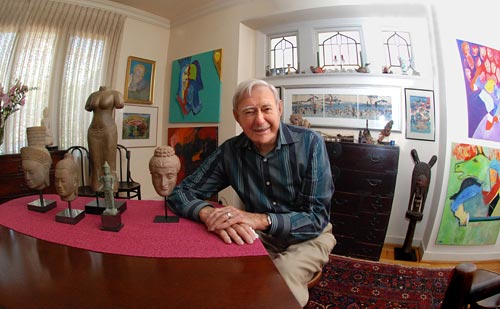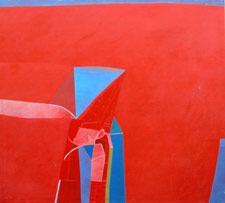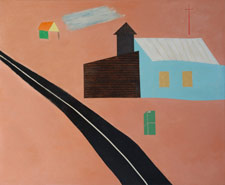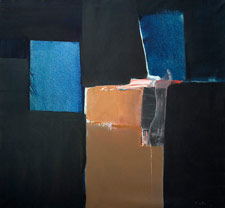 |
Treasures from a lifetime of creation and collection give Karl Kasten’s home the feel of an art gallery. At right, three paintings from the current exhibit of his work on display in Kroeber Hall’s Worth Ryder Gallery. (Peg Skorpinski photo) |
Karl Kasten keeps his hand in
The emeritus professor of art practice — a member of the famed Berkeley School — remains active and energetic. So does his art, now on display in a campus retrospective
| 01 October 2008
Up in his studio, the old attic of his North Berkeley home, Karl Kasten whips a large, geometric painting in cool silver off the wall he uses as his easel. In its place, he hangs a slightly less recent work, an abstracted but discernibly female figure in bold reds, oranges, and pinks.
 Konocti (Courtesy Brian Westbrook)
Konocti (Courtesy Brian Westbrook)“Venus with a big bottom,” a vigorous, referential work inspired by a Paleolithic statue, explains Kasten, an emeritus professor of art practice whose history at Berkeley stretches back more than 70 years. “I think I’m going to be doing more like this one.”
Age may be starting to nip at his heels, but Kasten keeps his phenomenal artistic energy moving forward. At “92 going on 93,” he’s up in his studio every morning, though he rides a rickety elevator-funicular up the narrow steps these days. He built it himself from an electric winch, a rail, and a wood platform just big enough for his two feet. Behind him, he trails a clear-plastic tube delivering oxygen from a pump on the first floor.
“They give me a lot of rope,” he jokes, as he offers a reporter a tour of the imposing stucco home, built for a Hawaiian princess, that he and his wife, Georgette, have gradually filled with art treasures over 48 years. Even the walls of a first-floor quarter-bath, tucked under the stairs, are crowded with artworks, 15 in all, from contemporary pieces by local artists Yuzo Nakano and Keiko Nelson to a Goya etching and aquatint to a 13th-century German woodcut to a simple color-pencil drawing by Alice Crittendon, Kasten’s first art teacher.
The occasion for the tour, and our interview, is a retrospective of Kasten’s paintings on exhibit at the Worth Ryder Gallery in Kroeber Hall through Oct. 24.
Kasten is best-known at Berkeley for his printmaking, and for introducing programs in printmaking and the study of art materials and techniques. But he’s always been a painter too, and the retrospective illuminates his contributions to the field as both an artist and an educator.
The main part of the exhibit focuses on Kasten’s Abstract Expressionist work and his later, more geometric paintings, spanning the years 1954 to 1987.
“They’re very explosive paintings, very vital. The strokes are vigorous but not aggressive,” says Kevin Radley, director of the gallery, a senior lecturer in art practice, and curator of the exhibit.
 Gold Hill (Courtesy David Keaton)
Gold Hill (Courtesy David Keaton)A room off the main gallery provides the context for Kasten’s work. On display are paintings by the artists who served on Berkeley’s art faculty when Kasten first came to the university as a student in the mid-1930s, and later were his colleagues after he returned to teach in 1950.
It was Kasten who insisted that the exhibit extend beyond his own work, in order to give recognition to the regional-art movement, centered on campus from the 1920s through ’40s, that became known as the Berkeley School.
The exhibit makes the case that the Berkeley School’s focus on line quality and color flow, influenced by the German-American artist Hans Hofmann, anticipated Abstract Expressionism, which came to dominate American art from the late 1940s on. Bay Area art critic Alfred Frankenstein is credited with coining the term Berkeley School in a 1937 review.
Father of the Berkeley School was Worth Ryder, whom Kasten calls his “great mentor, benefactor, and god.” Ryder, as art-department chair, hired a faculty that was extraordinarily diverse and youthful for its time, Radley says. He brought in Chiura Obata, Berkeley’s first Asian American faculty member, Margaret Peterson O’Hagan, the first woman on the art faculty, and James McCray, the first disabled artist, according to Radley. With Earl Lorin, John Haley, and others, they formed the core of the Berkeley School.
“It was the first layer of what modern art could be in the university,” Radley said at the exhibit’s opening.
Work by all these artists is on display, showing the influence of Hofmann, an early practitioner of the bold styles that led to Abstract Expressionism, with whom they studied and who taught summer sessions at Berkeley, at Ryder’s invitation, in the early 1930s. Kasten went to Cape Cod to learn from him in 1952.
A vibrant lithograph made at Berkeley by Willem de Kooning, another of Kasten’s art heroes, is included, too. Kasten brought de Kooning to Berkeley in 1960 to try out the art department’s print studio. The print now belongs to the Berkeley Art Museum, a gift of Kasten.
 Ramparts (Courtesy David Keaton)
Ramparts (Courtesy David Keaton)The exhibit also looks forward, including works of Kasten’s students and more recent works influenced by them. Kasten retired in 1983.
Kasten, on hand for the opening of the exhibit, pointed to Ryder’s 1927 work, High Sierra Lake, a landscape wrought in strong lines and streaks of color, as groundbreaking. “It was 20 years before anyone else got with this kind of vigor in painting,” Kasten said. Next to it hangs Chiura Obata’s charcoal sketch of Ryder as he painted that very watercolor.
Kasten, who graduated from Berkeley in 1938 (he designed card stunts for the Rose Bowl game that year), earned his master’s here and became Ryder’s teaching assistant and part of the Berkeley School before World War II intervened.
“I was with [Obata] the night before Pearl Harbor,” Kasten recalled. Kasten was inducted into the Army right after that; Obata and his family were sent to the Topaz internment camp in Utah.
Kasten didn’t return until 1950, the third time Ryder offered him a job. By then he’d spent two winters at the University of Michigan before heading back to the warmer clime of his native city, San Francisco.
In 1957 he met Georgette Gautrier, an adventuresome, Brittany-born Frenchwoman with “luscious red hair,” as Kasten recently described her to Artworks Magazine writer Erin Clark. As she tells it, Kasten first set eyes on Georgette onboard a ship crossing the Atlantic. They danced, then met for their first official date at the Metropolitan Museum of Art in New York. They married a year later.
Now, on the walls of their home, all of Kasten’s artistic expressions and influences are in full view — including a Hiroshige triptych woodcut he found for next to nothing in a used-book store; a late-Renaissance oil of the birth of Jesus; doodlings by David Hockney, done during a visit to Kasten’s office; and his most recent acquisition — five Cambodian statues, including two Buddha heads.
Dominating are large canvases of his own, showing both his abstract and referential styles.
In the kitchen hangs a large oil of a crew team rowing, their numbers on their shirts, from a series he did when he became fascinated with the “purity of numbers — you can’t have a good 8 or a bad 8,” he says. “It’s just 8.”
In a nearby hallway is a gouache he did that “shows Hans Hofmann’s influence, the vigor, the action. You don’t paint with your finger anymore, you paint with your whole arm, your body.” Another refers to Gauguin, “my hero. He was the first to use the word abstraction. He said if you feel like painting the sky red, paint it red.”
As he works his way through the house, it’s clear that Kasten’s passion for art burns as hot as ever. He’s also had time to write a memoir, Foghorns and Peacocks: The City. Art. War. The Berkeley School. And, 25 years after his retirement, he has remained active on campus. At the Faculty Club, he’s built a small permanent exhibit of Berkeley School work in the O’Neill Room.
Stopping to take in the beauty of a piece sitting in front of his dining-room window, Kasten says, “Who ever thought I would have an alabaster Buddha from India?” A pause, and then he adds: “God, I’ve been so lucky all along.”

